Here’s how to get the rose garden ready to go before the last hard freeze!
Spring is coming up fast, and that means it’s time to get ahead of the game in the rose garden. Even if the roses aren’t budding out, there’s still a lot to be done. All of these tasks will help you stay ahead of the game once the roses start blooming.
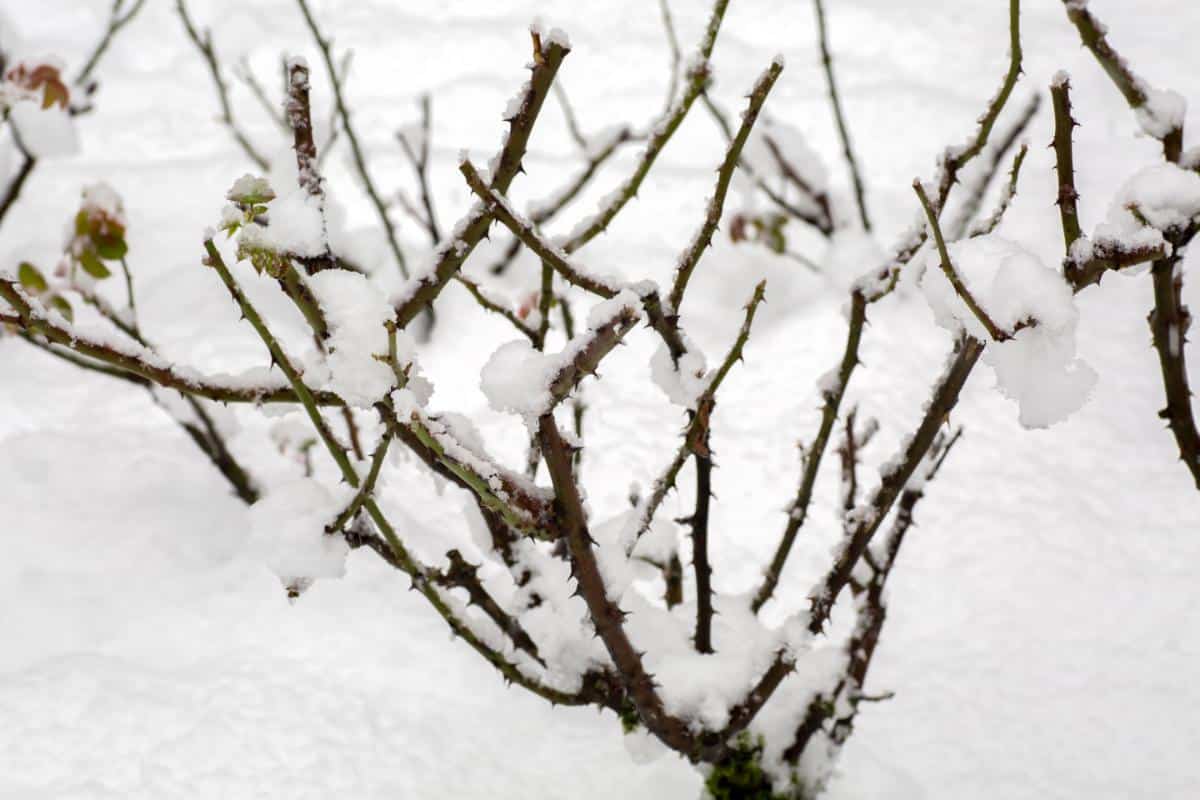
Jump to:
- 1. Organize and Make Lists to Prepare for Spring
- 2. Clean and Prepare Rose Garden Tools
- 3. Clean Up Weeds in the Rose Garden
- 4. Take Care of the Soil
- 5. Make Good Spraying Choices
- 6. Cut Back on Unnecessary Chemical Use
- 7. Plant Bare-Root Roses as Soon as They Arrive
- 8. Uncover Roses and Add the Perfect Mulch
- 9. Put Off Pruning Until After Hard Freezes Pass
- 10. Jump-Start Roses with Fertilizer
- 11. Time to Water the Roses
1. Organize and Make Lists to Prepare for Spring
While the weather is lousy, there are still plenty of ways to get ready for the big spring season.
- Start by organizing your workspace and garden shed. This will save you so much time in spring when everything is happening at once and needs tending immediately!
- Make lists of any fertilizers, soil amendments, or organic fungicides and pesticides you need to purchase before the spring roses start blooming.
- Invest in a pair of rose gauntlets if you haven’t already. These are gardening gloves with a long, thornproof sleeve to protect you from thorns. Rose gauntlets are great. Rose gauntlets allow me to clean up the thorniest roses (I’m looking at you, William Baffin) and keep my arms from looking like they’d been attacked by feral cats.
2. Clean and Prepare Rose Garden Tools
- Clean off spades, shovels, rakes, hoes, and other garden implements. Use a stiff wire brush or putty knife on the blade to scrub off dirt and rust.
- Sharpen a large tool by affixing the handle to a bench vise. Use a metal file to sharpen the edge, matching the angle of the original beveled edge and pushing the file away from you. (Safety first.) Work slowly and evenly until a shine appears along the whole sharpened edge. Turn the tool over, place the metal file flat on the back of the tool, and remove burrs by lightly pushing the metal file away from you. Then, use an old rag to rub down the blade with WD-40 or penetrating oil.
- Check wooden handles for splinters and sand them down. If you’re a woodworker with a spokeshave, use it to smooth handles that are in rough shape. Use a rag to rub boiled linseed oil into the wood, let it dry for 10 minutes, then rub the handle with a clean rag until it feels dry. Let it cure for a day, then repeat if you want improved results.
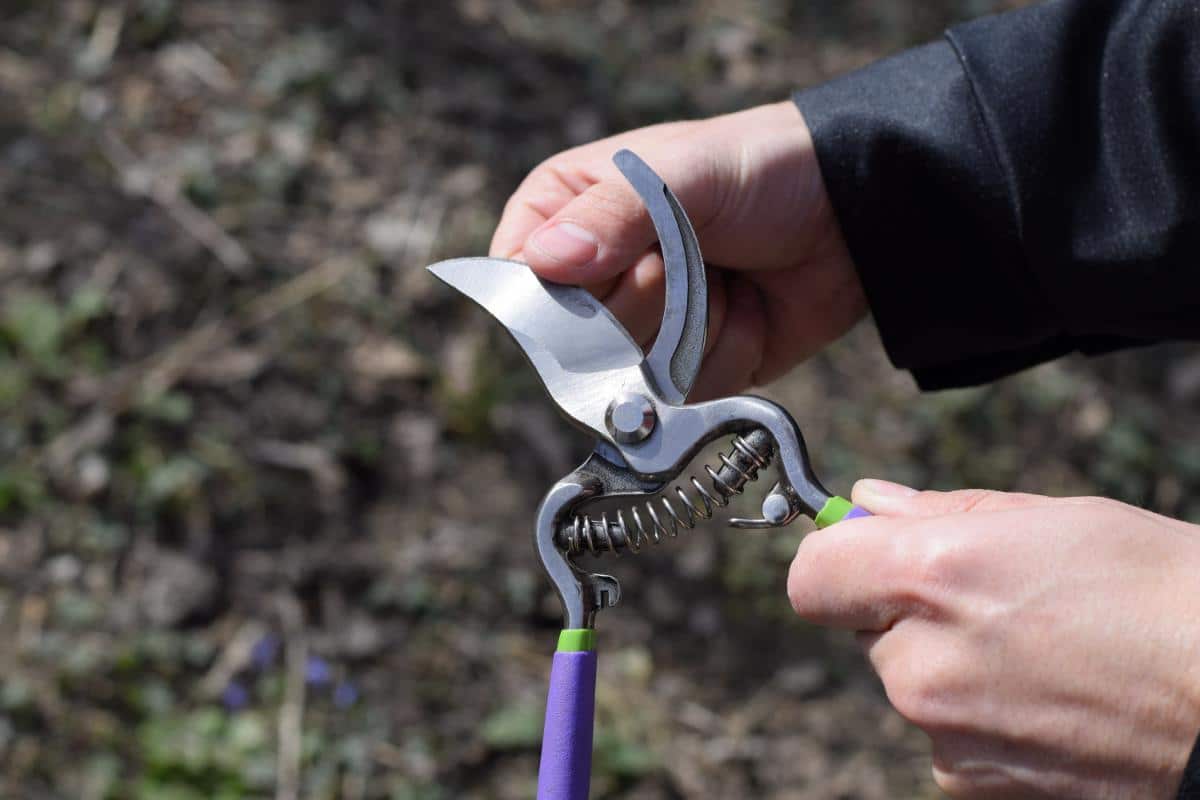
- Sharpen and oil your pruners. Clean off any old sap accumulated on the blade. A little maintenance will prolong their life and make them safer to use.
- Thoroughly clean handheld or backpack sprayers. Fill with water and a few drops of dish soap, shake it, and pour it out. Refill it with clean water and spray it to clean out the wand and nozzle. If possible, take apart the wand and clean the nozzle and filters. Be sure to do this on a clean surface so tiny parts don’t vanish! Backpack sprayers also have a filter where the hose meets the tank that can be cleaned out.
Read more: 28 Climbing Rose Varieties and Growing Guide + Mistakes to Avoid
3. Clean Up Weeds in the Rose Garden
Start weeding the spring rose garden as soon as the ground can be worked. Early spring weeds such as henbit (the purple flowering one) and chickweed (which is edible) will start to grow when days and nights are still chilly. These weeds can be pulled or hoed up before they start spreading.
Perennial weeds such as thistle and Johnson grass aren’t growing, but they’re soaking up the sun and storing energy in their roots. Dig them up, roots and all. Here are 17 ways to make weeding faster, easier, and more effective.
If you have a lot of weeds, herbicidal vinegar is a good organic solution that’s available in some garden or retail stores.
Note that this is not the kind of vinegar you sprinkle on your salad. Herbicidal vinegar contains 10 to 20 percent acid – it will burn your eyes and skin. It burns plants on contact but breaks down quickly in the soil, so it causes very little harm to the environment. Vinegar is a contact herbicide, only killing what it touches, so perennial weeds will keep sending up shoots. Spray new shoots as soon as they appear until the weeds use up their stored energy and die from exhaustion.
4. Take Care of the Soil
Check roses for frost heaving. If the freezing and thawing temperatures have caused your rose roots to be pushed up out of the ground, gently tamp them back in. Then, add a nice, thick layer of mulch to keep soil temperatures at a constant level. There will be more about mulch later in this article.
Don’t dig in wet soils! This destroys soil structure and leaves it compacted for many years. Check the soil by picking up a handful and squeezing it. If the soil sticks to your hand, or if the ball stays in one piece and doesn’t fall apart, it’s too wet to work.
Clear away mulch and add compost around each rose. This adds organic material that helps the soil stay light and fluffy.
5. Make Good Spraying Choices
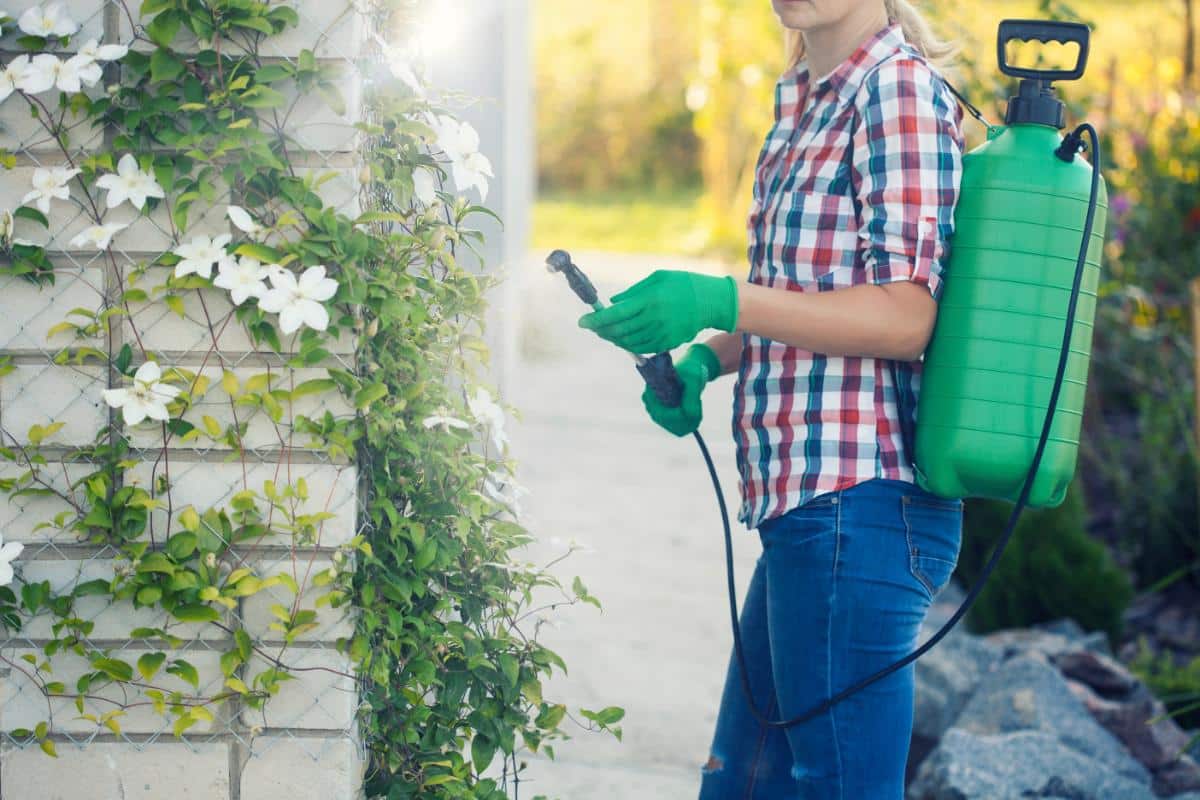
Spray dormant oil on roses when the temperatures are above freezing while buds are tightly closed and still sleeping. Dormant oil controls scale and other insect pests on roses. It also stops pests on pines, magnolias, and fruit trees.
However, if buds are swelling and new shoots are appearing on the roses, put the dormant oil away because it will damage new growth.
Spraying an anti-desiccant such as Wilt-Pruf or Wilt-Stop on rose canes helps to hold in moisture, acts as a disease repellent, and makes the leaves nice and shiny. It stops winter burn from wind and cold temperatures.
6. Cut Back on Unnecessary Chemical Use
This year, cut back or even ditch insecticides except in cases of severe infestations. The ecological costs are too high, and there are lots of good, organic ways to stop pest insects in their tracks. The same goes for unnecessary chemicals, herbicides, and fertilizers. Mulches (detailed below) will stop weeds, while beneficial insects and observation can help you keep insect infestations to a minimum.
There are a number of ways to grow roses that don’t require harmful chemicals, though it does take practice and time to learn new ways of working with roses. And not buying chemicals will save money that would be better spent on more roses, naturally.
Safety First When Spraying: Always wear eye and skin protection when spraying roses (or anything else). Spray only on calm days with no wind. Keep the nozzle close to the plant and spray the leaves until they’re dripping. Apply sprays only to the plants that need it. Keep animals out of the garden for a day after spraying. And always read and follow label directions!
7. Plant Bare-Root Roses as Soon as They Arrive

Bare-root rose orders should be arriving soon. When you get a message from the rose company saying your roses are in transit, go to the planting site, dig the big holes, and get the mulch ready.
When the big box of roses shows up on your doorstep, bring them in and unbox them.
Fill a five-gallon bucket with enough water to cover the roses’ roots. Add a little dash of bleach to kill off germs. Soak the roots for 24 hours, but no more than 48 hours.
Plant the roses as soon as possible in the big holes you’ve already dug. Add your favorite amendments to enrich the soil. Place the bud union of the bare-root rose a little bit below ground. Plant it deeper in northern gardens.
Once the rose is planted, mound soil or compost over the rose, leaving the tops of the canes poking out. Then, cover all of that with mulch.
Water the bare-root roses weekly. Start removing the mulch once the sprouts start growing – but leave the mounded soil in place! This will hold in moisture and protect the young canes for the rest of the year. Add a thick layer of mulch around the rose for additional moisture and protection.
8. Uncover Roses and Add the Perfect Mulch
Before your last frost date, start gradually uncovering roses that have been covered with mulch. If soil or compost is mounded up around the canes, use the water hose to rinse away some – but not all – of it. Don’t uncover the roses too quickly. Remove just enough to help new sprouts grow and slowly accustom themselves to the weather while protecting the rest of the rose from sudden temperature changes and sub-zero weather.
Here’s a great way to keep weeds down this year.
- Push aside the mulch that’s already in the garden.
- Cover the ground around the roses with sheets of cardboard and flattened boxes.
- Cover the cardboard with the old mulch.
- Pile a bunch of new mulch on top until the cardboard is completely hidden.
- Boom! No more weeds!!
The cardboard will smother even perennial weeds. If a stubborn weed does poke through, clear away the mulch, lay a big piece of cardboard right on top of it, and cover it with mulch.
As a former rosarian who used to spend all day fighting weeds in the city rose garden, mere words cannot express how much I love cardboard mulch.
9. Put Off Pruning Until After Hard Freezes Pass
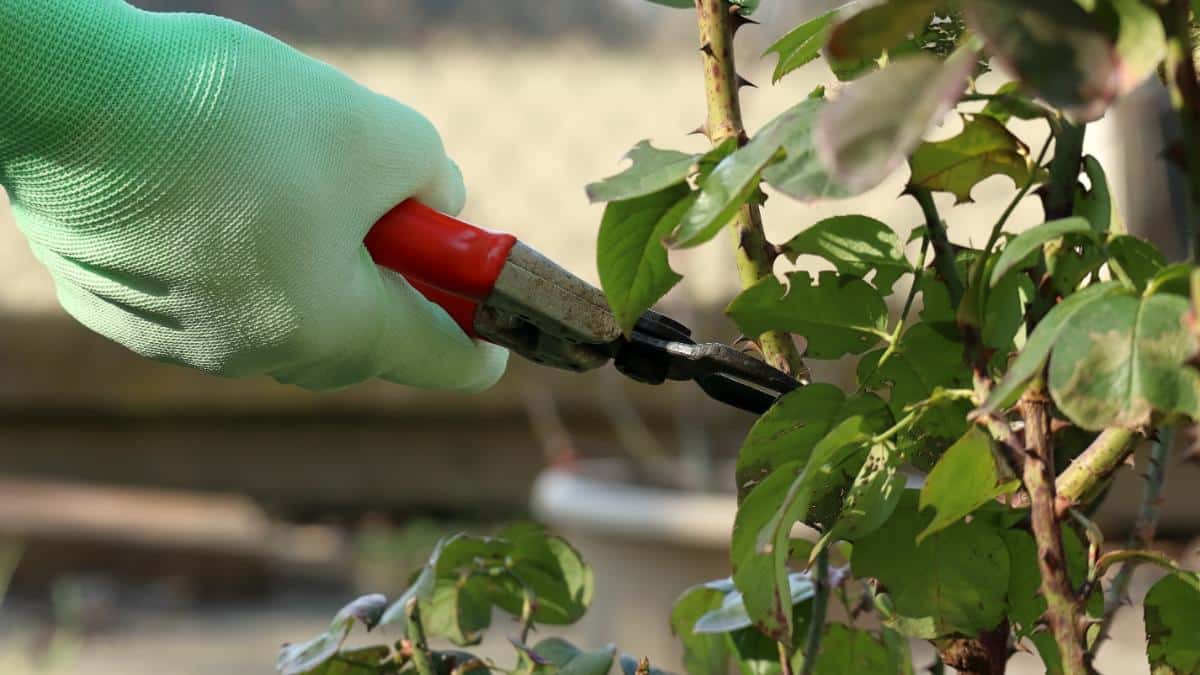
Wait until hard freezes have passed to prune. This is because pruning encourages new growth – and if the new growth emerges right before a freeze, it could turn black and die, setting the rose back.
10. Jump-Start Roses with Fertilizer
Once the new growth is two inches long, add fertilizer around the base of the rose. Use an organic, slow-release fertilizer such as Espoma Rose-Tone or Down to Earth Rose & Flower Mix. Add in compost as well, then cultivate it into the soil. Compost adds a few nutrients but also adds organic material to the soil, which roses love.
11. Time to Water the Roses
Put up a rain gauge near your garden so you can see how much rain you get every week. If you get an inch or more of rain, you can skip watering.
If you use soaker hoses or drip irrigation, lay them out now and cover them with mulch, but don’t run water through them until after the last hard frost. Don’t take a chance that they might freeze and break.
After roses sprout, start weekly watering on temperate days when the temperature is above freezing. Naturally, don’t worry about watering if you’re being hit with freezing temperatures and snowstorms. Roses appreciate the extra water.

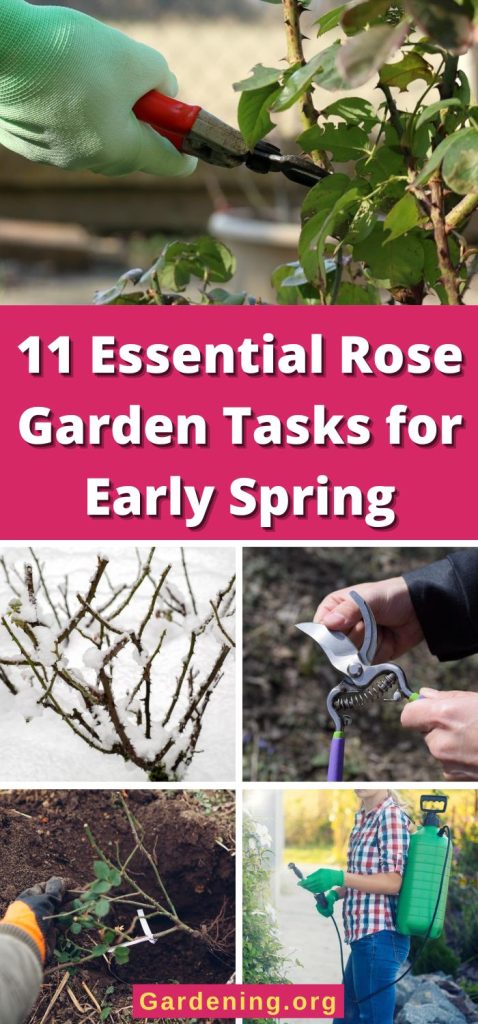






Pat herron
Thank you very much , very helpful
Rosefiend
Thank you! Glad to be of service!